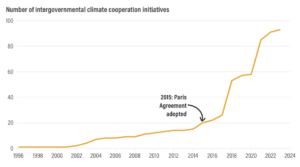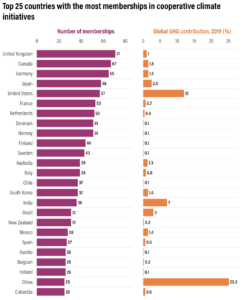James Hansen claims that climate scientists have been too slow to ring the alarm bells. Not so, says Michael Mann. International climate treaties are booming post-Paris. Putting trousers on a starfish.
Tackling climate change: are we already too late?
The heat is rising among climate scientists. In part about the research evidence and its interpretation; in part about what to do and the urgency of doing it.
It doesn’t do the issues and their proponents full justice but I’m going to dichotomise the arguments for clarity.
In one corner we have the highly respected (retired NASA) scientist and activist James Hansen, hero of the climate movement since he blew the whistle about global warming to a US Senate Committee in 1988. In a recent, very long and very technical article, Hansen and colleagues argue that the Intergovernmental Panel on Climate Change (IPCC) has underestimated:
- the strength of the relationship between the increase in the concentration of CO2 in the atmosphere and the increase in global warming that it causes. The authors believe warming is close to 5oC for a doubling of CO2 in the atmosphere.
- the amount of global warming that is locked in the pipeline, regardless of what we now do about emissions, because of the long delays in the feedback loops in Earth’s natural systems. ‘Global warming in the pipeline’ is in fact the title of the paper.
- the one-off increase in global warming that is caused by a reduction of the sulphate aerosols in the atmosphere as the burning of fossil fuels is reduced.
- the amount by which the solar energy absorbed by the Earth exceeds the thermal energy radiated out. The authors claim that the difference (Earth’s energy imbalance) has doubled since 2010.
- the likelihood of catastrophic non-linear events (tipping points) occurring in the next century, for instance cessation of the Atlantic Ocean’s circulation currents, rapid melting of polar ice sheets and increased sea levels.
Hansen is critical of scientific colleagues and the IPCC for being resistant to new or challenging ideas. He also suggests that reticence and a preference for ‘gradualism’ prevent scientists from forcefully presenting warnings before it’s too late to the public and policymakers about the seriousness of the risks and technical advice on policy options.
The authors, who come from ten institutions in six countries, make four main recommendations:
- a rising carbon price to rapidly drive down CO2 emissions, accompanied by the development of abundant renewable energy.
- greater cooperation between the West and China to accommodate the needs of the developing world.
- to facilitate climate action, young people must drive democratic change (this is with reference to the USA but is relevant beyond).
- reversal of the imbalance between Earth’s incoming and outgoing energy. The authors opine that as controlling greenhouse gas emissions is necessary but no longer sufficient and carbon capture and storage is fool’s gold, temporary solar radiation management will probably be needed and research should be conducted now into its application and potential unintended effects.
Although the scientific details in the Hansen article is far too arcane for 99.99% of us, I strongly recommend the very readable first (‘Background information and structure of the paper’) and final (‘Politics and climate change’) sections.
In the opposite corner is Michael Mann, another climate scientist and activist. Also a climate movement hero (and devil incarnate to others) since he published in 1998 the (ice) hockey stick graph of global warming over the last thousand years. Mann has challenged Hansen’s evidence and conclusions, basically saying that the IPCC’s findings are correct. In summary, he says that the most recent evidence and modelling indicate that:
- the global warming associated with a doubling of CO2 in the atmosphere is in the 2.5-3oC range.
- there is no ‘warming in the pipeline’. When greenhouse gas emissions stop, further warming will stop.
- Earth’s energy imbalance is not increasing, as demonstrated by the constant, not increasing, rate of increase in the heat content of the oceans (where 90% of global warming’s heat is stored) since the late 1980s.
- there is no evidence that the rate of the Earth’s surface warming has been accelerating in recent decades.
- IPCC’s climate models have accurately predicted the observed warming to date.
- there is no evidence that changes to ship-based sulphur dioxide aerosols in the air have played any substantial role in recent warming trends.
Mann also disagrees with the lessons that can be learnt from changes in the Earth’s temperature over the last 66 million years and that they support Hansen’s thesis.
Overall, Mann concludes that ‘the truth is bad enough [but] there is no reason that we can’t prevent dangerous levels of warming through concerted efforts to decarbonise the global economy. The obstacles, at least at present, are political, not physical or even technological’. He does, however, agree that ‘it is important to think about strategies for carbon drawdown down the road’, while not going so far as to advocate for solar radiation management.
A more detailed but very readable discussion of the scientific issues and differences in their interpretation among climate scientists can be found here.
It’s important to remember, though, that there is one thing that Hansen and Mann, and almost all climate scientists, do strongly agree about: the urgent need to rapidly reduce and eliminate the burning of all fossil fuels.
To some, these debates between climate cognoscenti will be comparable to theologians arguing about the number of angels that could dance on the head of a pin. To climate deniers, the disagreements will, no doubt, be portrayed as proof that the evidence is fictitious, invented by a conspiracy by communists and elites to deny our sovereign agency and scientists to get research grants. To me, they signify healthy debate over some details and overwhelming agreement by those who understand the science that unless we do something right now, disaster is hurtling towards us. The dinosaurs couldn’t see it coming. We can.
Solar geoengineering, one scientist’s ‘worst nightmare’
In the view of Peter Kalmus, a current NASA climate scientist, ‘my worst nightmare is continued fossil fuel expansion accompanied by solar geoengineering followed by termination shock. This would be game over for human civilisation and much of life on Earth.’
(‘Termination shock’ is the massive increase in global warming that would accompany the termination of a period of solar radiation management if the level of CO2 in the atmosphere had kept rising during its application.)
Climate treaties and greenhouse gas emissions booming
The 2015 Paris agreement on climate change has been incredibly successful. No, not at reducing emissions, silly. At stimulating the formation of international pledges, agendas, treaties, communities, challenges, coalitions, hubs, dialogues, compacts, initiatives, partnerships, platforms, agencies, alliances, campaigns, forums, etc. (the thesaurus has been well thumbed) to tackle climate change. There were 20 in 2015, now there are 93.

Most agreements have been initiated by governments of developed countries and other developed countries love to join them.

What do they do? Two-thirds are focused mainly on sharing information.
What have they achieved? Process, lots of process. Governments are good at process. The World Resources Institute (WRI) developed indexes of activity (providing incentives for members to act) and operation (administrative infrastructure, transparency and appointing champions to senior roles), each with a low, medium and high level of achievement. Only 18% of the treaties scored ‘high’ for activity, whereas 61% achieved ‘high’ for their operational features.
The WRI recommends:
- move beyond knowledge sharing to cooperation on the implementation of policies that stimulate investments, research, green technology development and roll-out, and public climate finance.
- agree science-based goals, targets and road maps for decarbonisation.
- increase the participation of and leadership by developing nations.
Genuine mistakes or malicious lies?
According to a post on Facebook, a wind turbine has to spin continuously for over 4 years to replace the energy it took to manufacture it and turbine blades last only 3-7 years.
Not so. The evidence indicates that it takes only 6 months for a turbine to generate more energy than it took to make it (the ‘Energy-Payback Time’) and turbine blades have a lifespan of 20 years.
The misinformation about EVs is ubiquitous: an EV must travel 80,000+ km to break even; EVs have little CO2 advantage over petrol cars; EVs explode – petrol ones only do it in movies. These and 18 other myths have been factchecked and exploded.
And here’s a cracker: wind turbine noise causes cancer. Who said that? – Take an educated guess.
Anyway, moving on, as I’m sure you’re all aware, starfish aren’t fish. They are echinoderms and their proper name is sea stars. Mind you, silverfish aren’t fish either; they are insects! Perhaps inconsistency confers some evolutionary advantage on humans but more seriously …
How should you clothe a starfish?
Most higher animals are bilaterians – that is, they are symmetrical around a longitudinal axis and have a front and a rear end (think lion or frog or kookaburra). But most bilaterians are not completely identical on the right and left sides. For instance, we humans have quite a few organs that are distinctly asymmetrical (e.g., heart, liver, spleen, stomach, intestines).
On the other hand, some animals, for instance starfish, have radial symmetry, which begs the question posed in the 4-minute video: How would a starfish wear trousers?
Like this:

or this?

Its genes suggest that it should dispense with jeans altogether and go the Fully Monty.

Peter Sainsbury is a retired public health worker with a long interest in social policy, particularly social justice, and now focusing on climate change and environmental sustainability. He is extremely pessimistic about the world avoiding catastrophic global warming.

